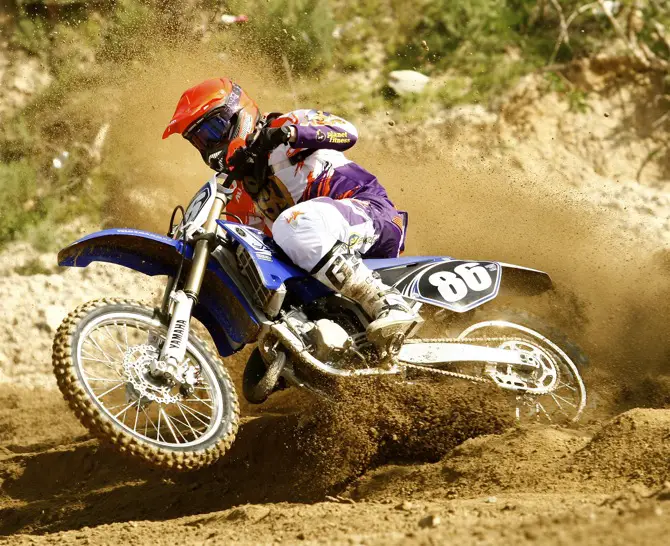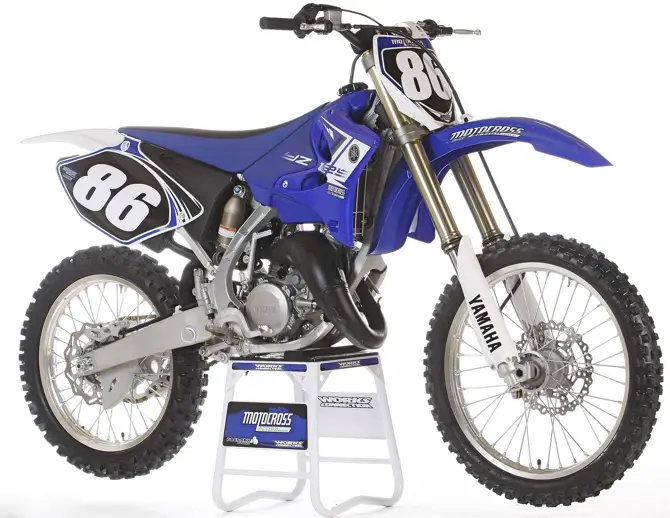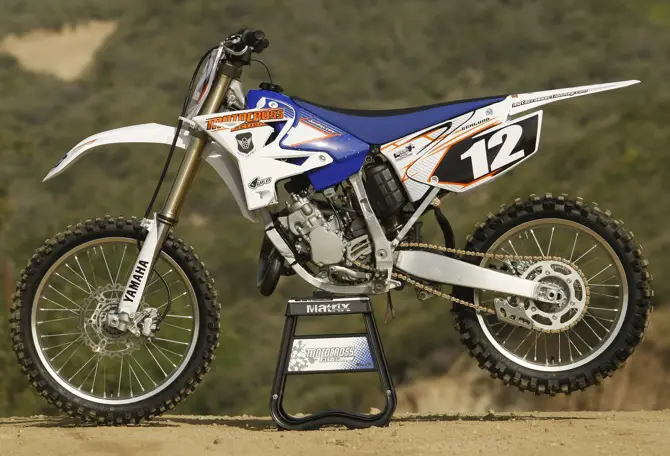MXA’S 2013 YAMAHA YZ125 TWO-STROKE TEST: THE LITTLE BIKE THAT COULD …IF ONLY SOMEONE WOULD GIVE IT A CHANCE

Q: FIRST AND FOREMOST, WHY DOES YAMAHA KEEP BUILDING AND MXA KEEP TESTING THE YZ125?
A: It may sound melodramatic to say, but the YZ125 is the most important bike in modern motocross history. Not only was it a great race bike during its heyday, but there will come a time when every manufacturer, race promoter, rider and AMA functionary will rue the day that the AMA saotaged the 125cc two-stroke with its wholly unfair four-stroke displacement and fuel rules. We will all miss the 125 two-stroke when its gone?because gone with it will be the next generation of young racers.
Why do we say that? Four reasons: (1) Cost. Thanks to its simplicity a YZ125 is cheaper for Yamaha to build and cheaper for an aspiring racer to maintain than a 250cc four-stroke. (2) Weight. At under 200 pounds, a 125 two-stroke is easily managed by pubescent teenagers fresh out of the 85cc class. (3) Learning curve. Not every person riding a motorcycle needs an expensive, heavy and complex starter machine. A 125cc two-stroke teaches valuable riding skills, while maximizing fun. (4) Entry level. The demise of low-cost, 125cc two-strokes raises the price of entry to the world of motocross. As with all sports, the higher the costs the lower the number of aspirants.

2013 Yamaha YZ125: Over the year the YZ125 has seen only modest updates and 2013 mods are as modest as they come. The white rear fender and new radiator shroud graphics are the only changes between 2012 and 2013.
Q: DIDN’T MXA HURT YZ125 SALES BY WRITING RAVE REVIEWS ABOUT 250 FOUR-STROKES?
A: Much like Bonnie and Clyde who, when ask what they did for a living, said, “We rob banks,” the MXA could easily paraphrase that into “We test bikes.” We test what is offered to the public and we go to great lengths to tell the truth about those bikes. One of those truths is that a twice-as-larger 250cc four-stroke has a better, broader and more usable powerband than a 125cc two-stroke. When you put millions of dollars worth of four-stroke development up against a new white fender or a downsized front brake clamp, the outcome is predetermined. MXA’s bike tests did hurt Yamaha YZ125 sales. But, we tried to warn Yamaha that benign neglect was a bad policy.
In fact, way back in 2009, MXA asked Yamaha to build a 150cc version of the YZ125. Our reasoning was based on the fact that since 125cc two-strokes had been legislated to the edge of extinction, Yamaha should pursue the entry-level market with a bike that was better suited to play riding and professional practice racing. We told Yamaha that KTM sold three-times as many KTM 150SX’s as they did 125SX’s. And, that small-bore two-stroke sales would be better served by a bike with three more horsepower to deal with changing modern track designs and the desires of current riders. Yamaha refused on the grounds that the distributors in other countries would not sign off on a YZ150 project.

Q: WHAT CHANGES HAS YAMAHA MADE TO THE YZ125 SINCE 2005?
A: Here is a very brief history of YZ125 development.
2005 YZ125: The 2005 Yamaha YZ125 is the acorn from which the 2013 YZ125 has grown. It was the first YZ125 with an aluminum frame and it weighed 4-1/2 pounds less than 2004’s steel frame. The Kayaba forks were copies of Showa’s Twin-Chamber forks. We called them “Showabas.”
2006 YZ125: The greatest change in YZ history came in 2006 when Yamaha introduced its SSS suspension components to replace 2005’s Showabas. Not only was SSS a revelation, but the shock had an 18mm shock shaft instead of 16mm shaft, Kashima-coated internals, 30 percent larger reservoir and a titanium shock spring.
2007 YZ125: Changes to the 2007 YZ125 were minimal and limited to tapered stanchions, aluminum spacers and collars and Pro Taper oversize bars.
2008 YZ125: The 2008 YZ125 borrowed the front brake caliper, fork stanchions, lower fork bracket and chain guide from the YZ250F. There was a new reed valve and the fork spring rate was upped from 0.41 to 0.42 kg/mm.
2009 YZ125: The big ballyhoo of 2009 was the lightweight, aluminum, front brake cable holder, textured seat cover and Dunlop 742F front tire.
2010 YZ125: BNG.
2011 YZ125: The 2011 model got the global spec mods that made every YZ125 in the world the same, they included a 75mm longer silencer and perf core size increase (from 27mm to 30 mm). The long-standing 410 main jet was replaced with a 430 (and the 6BFY42-3 needle was swapped out for a 6BFY43-3 needle).
2012 YZ125: BNG.
2013 YZ125: A white rear fender was added along with new tank graphics.

The YZ125 engine may be old, but it’s still competitive. One of its big pluses is that it can be rebuild by a monkey with a screwdriver for the spare change on your truck’s floor.
Q: IS THE 2013 YZ125 FASTER THAN THE 2012 YZ125?
A: It can’t be faster than the 2012 model (or the 2010, 2009, 2008 or 2007 for that matter) because it shares the same engine. It might even be a little slower thanks to the global-spec changes.
Q: HOW MUCH HORSEPOWER DOES THE 2013 YZ125 MAKE?
A: It makes 34.01 horsepower.
Q: HOW DOES THAT COMPARED TO THE KTM 125SX AND KTM 150SX?
A: At 34.01 horsepower the YZ125 is only six-tenths of a horsepower off of the KTM 125SX (which peaked at 34.66 at 11,200 rpm). Surprisingly, for an engine that hasn’t seen a serious mod in six years, the YZ125 holds its own. It never beats the 2013 KTM 125SX at any point on the curve and actually gives up several horsepower to the KTM in the middle (from 6000 rpm to 8400 rpm), but it sticks with it on top.
As for the 150SX, it hits 38.83 horsepower at 11,100 rpm. It is faster, stronger, broader and easier to ride.

Q: WHAT WOULD HAPPEN IF WE INSTALLED A YZ144 KIT
A: With Yamaha’s $859.95 GYTR big-bore 144cc kit, the YZ125 gains two more horsepower in the meat of the powerband and, best of all, it doesn’t lose any top-end power. The GYTR YZ144 kit includes a brand-new nickel carbide-plated Athena cylinder, cylinder head, 58mm piston with rings, pins, clips, gaskets; modified Power Valves, O-rings and complete instruction Best of all, it fits all 2005 through 2013 Yamaha YZ125 models.
The downside is that it still can’t match the KTM 150SX pony for pony, and the price tag ($859.95 plus splitting the cases) makes it expensive.
Q: WHAT IS IT LIKE TO RACE 2013 YAMAHA YZ125?
A: Once you adapt to the all-or-nothing riding tactics of successful 125 two-stroke racing, you understand why they used to sell 1,000,000 offroad bikes back in the glory days of two-strokes (as opposed to 70,000 today). It is more fun than a barrel of monkeys. The best tactic is to lock your right wrist, slap at the clutch with your left hand, tap dance on the shifter with your left toe and disconnect your frontal lobe. This is why motocross became popular so many years ago. Even when you are going slow, you feel like you couldn’t go any faster.
A 125cc two-stroke makes small tracks seem big, big tracks feel like the Bonneville Salt Flats and mid-sized jumps seem like Supercross triples. At 199 pounds, you don’t have to wrestle with, because if you did, you’d win. We have seen YZ125 riders beat a field full of 250 four-strokes. Heck, we seen them run down a pack of 450s. But, even if you don’t beat them, you have fun trying.

The best tactic for riding the YZ125 is that your throttle hand should never be rotated forward. You gotta pin it to win it.
Q: WHAT ARE THE BEST YZ125 HOP-UPS?
A: If you want to run with 250F’s or 150cc two-strokes, the YZ125 will need some help. Here is a quick list of things that YZ125 owners can do to make their bikes more competitive.
Gearing. Before you buy a pipe, port the engine or slip on aftermarket reeds, gear the YZ125 down. Adding one tooth will perk up second gear, get you to third gear sooner and make the overall ratios between the six gears more user friendly.
Pipe. Exhaust pipes are an easy way to add power. They add about two horsepower to a 125cc and cost one-third of what four-stroke exhaust systems cost. FMF and Pro Circuit YZ125 pipes cost less than $250.
Reeds. We run a Boyesen RAD Valve to broaden out the power. The $179.95 RAD valve is a complete replacement reed block and valve assembly. Boyesen can be reached www.boyesen.com or at (800) 441-1177.
Porting. A ported YZ125 (with head mods) is a potent high-rpm weapon. The cost to port the cylinder and mill the head is typically around $329.95. Contact Pro Circuit at www.procircuit.com.

This is what MXA’S YZ125, the same one as tested above, looked like at the 2013 World Two-Stroke Championships (where it finished in the top ten of the 125 Pro class). This is the UFO plastic kit with DeCal Works graphics.
Q: WHAT DID WE HATE?
A: The hate list:
(1) Look. We don’t mind riding an underdog machine against the new iron, but we hate that it looks ancient. But, with the UFO Restyle kit, you can modernize it quite a bit.
(2) Knowledge. We know that Yamaha could have built a YZ150 five years ago and we could be enjoying it now.
Q: WHAT DID WE LIKE?
A: The like list:
(1) Price. The KTM 125SX retails for $6449 and the 150SX costs $6599, so at $6290 the 2013 Yamaha YZ125 is $160 and $309 cheaper than its primary competition.
(2) Suspension. We absolutely love Yamaha’s SSS settings.
(3) Weight. At under 200 pounds, the YZ125 is 19 pounds lighter than a YZ250F, 23 pounds slighter than a CRF250 and 25-pounds lighter than a KX250F. Weight is important to consider when many young riders aren’t strong enough to lift their own body weight.
(4) Entry-level. A 125cc two-stroke is the perfect size machine for a minicycle transplant.

Cheap speed comes in the form of one tooth on the rear, an aftermarket pipe, new reeds and a port job.
Q: WHAT DO WE REALLY THINK?
A: We think that Yamaha has sat on the two-stroke fence for too long, which is better than Suzuki, Kawasaki and Honda did when they bolted from two-strokes six years ago. Yamaha hasn’t throw in the two-stroke towel yet, but their benign neglect is the death of a thousand cuts. Yes, we are glad that they still make two-strokes, but we aren’t glad that they still make 2006 two-strokes. Meanwhile, KTM sells 125cc, 150cc, 200cc, 250cc and 300cc two-strokes like they are going out of style. KTM can’t keep them on the showroom floors, while Yamaha doesn’t make enough two-strokes to even reach the showroom floors. If it’s worth doing, isn’t it worth doing right. The YZ125 could be awesome.
MXA’S 2013 YAMAHA YZ125 SETUP SPECS
Given that all suspension components are just stacks of metal shims and some oil, we don’t believe that there is any magic in Kayaba’s metal parts. The real genius lies in Yamaha’s test program. They choose the correct spring rates, design real world settings and make the conglomeration of wafer thin shims work like magic. This is how we set our Yamaha YZ125 up for racing. We offer it as a guide to help you find your own sweet spot.

There is nothing super special about the metal parts of Yamaha’s Kayaba SSS suspension. The reason they work so well is because Yamaha’s test riders and engineers choose real world settings.
KAYABA SSS FORK SETTINGS
The YZ125 has benefited from the advances that Kayaba has made on the YZ250F forks. Plus, with significantly lighter overall weight (the Kayaba SSS suspension works better on the 199-pound YZ125 than on the 218-pound YZ250F. Here is what the MXA wrecking crew ran for hardcore racing.
Spring rate: 0.42 kg/mm
Oil height: 340cc
Compression: 11 clicks out
Rebound: 6 clicks out
Fork leg height: 5 mm up
Notes: In 2007, the YZ125 came with lighter, 0.41 kg/mm fork springs which are better for many riders under the 150 pound mark.
KAYABA SSS SHOCK SETTINGS
For hardcore racing, we recommend this shock setup.
Spring rate: 4.7 kg/mm
Race sag: 98mm
Hi-compression: 1-1/2 turns out
Lo-compression: 13 clicks out
Rebound: 10 clicks out
Notes: The high-speed compression adjuster is sensitive, so make small (1/8 turn changes). It’s also a very important adjustment for keeping that rear wheel settled and for controlling wheelspin on hard choppy terrain.

The YZ125 come with a richer main jet, which we use when we add an exhaust pipe or the weather turns cool.
MIKUNI TMX JETTING SPECS
Yamaha has their jetting down and our 2013 YZ125 ran clean. Here are the 38mm Mikuni TMX jetting specs:
Mainjet: 430
Pilot jet: 40
Needle: 6BFY43-3
Clip: 3rd from top
Air Screw: 2-1/4 turns out
Note: Yamaha includes one richer (440) and one leaner mainjet (420) with the bike. The current 6BFY43-3 needle is a half-clip richer than the old 6BFY42-3 needle used before the global spec came in to play.




Comments are closed.